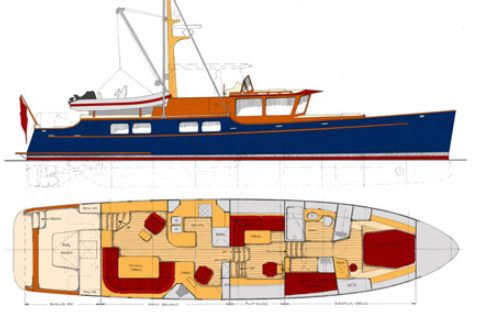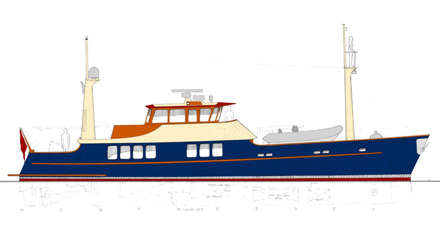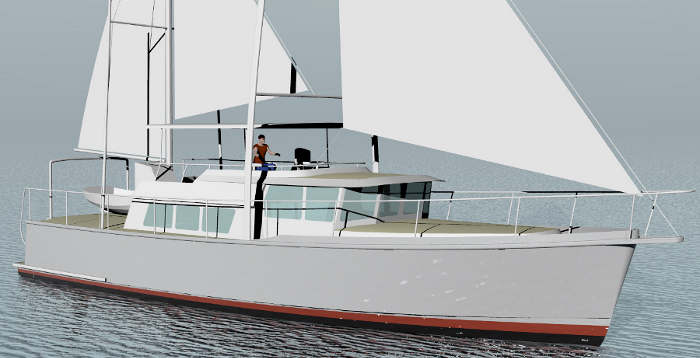Fuel use, efficiency, and ocean-crossing
 Passagemaker Lite design series is Tad Roberts' modern, lightweight, fuel-efficient re-statement of the fast, seaworthy, long-range power cruiser. There are now two series, the orginal traditional one and a modern one, in lengths from 39' to 98'. Read more:
Passagemaker Lite design series is Tad Roberts' modern, lightweight, fuel-efficient re-statement of the fast, seaworthy, long-range power cruiser. There are now two series, the orginal traditional one and a modern one, in lengths from 39' to 98'. Read more:
-
Passagemaker Lite: Real vs. Theoretical Fuel Consumption During Ocean Crossings
The Passagemaker Lite hull form is reasonably efficient under power; the form minimizes wave making and form drag with a long waterline and narrow beam. But there is a fairly large gap between theoretical fuel consumption and actual (ocean crossing) use. Let’s look a little more closely at real fuel consumption.
-
The Passagemaker Lite hull form is reasonably efficient under power; the form minimizes wave making and form drag with a long waterline and narrow beam. But there is a fairly large gap between theoretical fuel consumption and actual (ocean crossing) use. Let’s look a little more closely at real fuel consumption.
Like all problems involving boat design and the ocean, these differences, (theoretical to actual) are due to numerous variable factors. The two main factors involved are drag (resistance) and thrust (propulsive power).
Theoretical resistance models deal with wave making and wetted surface resistance. The forms of resistance not taken into account include bottom roughness and growth, wind and wave resistance, current and tide, and appendage drag. Thrust at the propeller and what the engine has to produce are different because of power loss in the system. There are alternators and water pumps running which require HP, there are loses in the gearbox and propeller shaft bearings, and propeller efficiency ranges from 50-70%. Power output and engine efficiency will also vary with fuel and air temperature.
While the PL 46 (bare hull theoretical model) does show a speed of slightly over 6 knots using somewhere between 9 and 11 Hp, that is Hp delivered at the propeller. It is without appendage drag, wind or waves or currents, etc. In reality few moderately sized modern engines will operate long term at that low an RPM. If the engine is run long term below operating temperature there will be damage. So 1200 RPM is probably minimum, and minimum fuel burn (real world ocean cruising) is probably closer to 1.3 usg/hr. or about 4.9 liters per hour for a speed of 6-6.5 knots. This is the speed and fuel use achieved by Idlewild on her recent circumnavigation using a single 55 HP engine.
The designed fuel capacity of the PL 46 is 860 usg or about 3250 liters. About 3% will remain in the tanks when empty. This is a useable 3150 liters, a minimum reserve should be 25%, so range should be based on a useable 2362 L. At 4.9L per hour this gives us 482 hours at 6.5 knots, which equals approximately 3100 miles. The reserve size should be based on voyage length and expected conditions, ie if your passage involves a high chance of encountering contrary weather conditions, the reserve should be much larger.
Where the PL concept comes into serious contention is coastal passages of 1000-1500 miles when she can run at speeds far above those 6.5-7 knot maximums of typical ocean crossing powerboats. At 9 knots the PL46 will be using less than 75Hp for a fuel burn of about 12.2L per hour. This is loaded at 32,000 pounds and without stabilizers or paravanes deployed.
-
Your Comments
-
- Peter Jacops
- April 3rd 2007, 8:22 am
we still have to decide if we go for two small fast speed engines or one big slow and a small fast engine or a big one with an electrical wing engine. All these possibilities have advantages and inconvenient. I would very much like the idea of the auxiliary electrical engines but that is very much depending on the prices of the new Lithium manganese batteries which are way more efficient than the classic type. But we are not sure yet how these prices will drop in the coming years.
-
- Tad
- April 5th 2007, 2:59 pm
Hi Peter, Smaller fuel cells are now coming into production for use on boats. Perhaps this will be a better (lighter and less costly) electric propulsion option in the not-too-far future? Tad
-
- David Law
- April 18th 2007, 3:29 am
Sir, would this passagemaker be lighter or more fuel efficient if it was made using Grp reinforced with Nida-Core hull and Grp Superstructure for flotation, Just wondering about alternative materials and their effect on the fuel efficiency and the design overall David
-
- David Law
- April 29th 2007, 8:26 pm
Love the design of the 56 but being long thin and not much draft will it roll ?? or be uncomfortable. Do you see this being used to cross oceans ? or mainly as a coastal cruiser ? With everything low is this also good for say French canals ? Could the 56 be made in Plywood Epoxy ? The design is more for a gentleman than a fisherman but why did such a great design die ?
-
- Tad
- May 2nd 2007, 2:19 pm
Thanks for your comments David, The denser the core the better impact resistance and the ability of a given panel to support itself between stiffeners. Nida Core (honeycomb) is mostly air, thus very light and is excellent for saving weight in things like cabin soles, roof tops, berth flats, etc. These are large flat areas with light to moderate loads and are not subject to impact. Every core material is subject to water ingress over time, honeycomb has big holes to fill with water making it very heavy when wet. I would recommend a denser Linear PVC foam core for the hull and deck of the PL's. This is Airex or Core-Cell. While foam is light, the downside is that it is very expensive in comparison to wood. A cedar core is reasonably light, tough, easy to work, and will have better impact resistance than any usual core material. Lighter weight and thus less wetted surface and wave making resistance means better economy. But is it economically sensible to double your hull cost to save 500 pounds in hull weight? I don't think so, better to increase length 10' and drop resistance by the same amount while increasing available interior. Every boat will roll, the trick is to control the roll at a level you are comfortable with. And for every individual this is different. In general my answer for rolling in the PL series is to limit height above waterline, this limits the distance traveled in each roll. As the boats are of lighter displacement the rolling will be quick. But many are un-aware that rolling can be tuned with raising or lowering of VCG. The only long-term control of rolling is with some form of stabilization, active fins, passive fins, paravanes, etc. These boats are all designed to make long passages, and this could certainly include crossing oceans. The fact is few folks actually do cross oceans in power boats, but the PL series are all designed to do so. I do have an alternate hull in multichine form which could be built in sheet material, plywood or aluminum. Dimensions are the same as the standard round bilge hulls. Long and narrow boats have been around a long time. Mainly their demise was pushed by the cost of marina berths (in feet overall), shorter with more interior will always win with the average consumer, except at the gas pump.
-
- WEST PEARSON
- May 28th 2007, 3:06 am
Tad: Have there been any thoughts about a diesel-electric propulsion system, such as OSSA or Siemens offer? Would you think there is enough room in the engine room for that type of system?
-
- Tad
- May 28th 2007, 12:35 pm
Hi West, Yes, there is great interest in working out an Ossa Powerlite system for use in the PL 46. The client for hull #2 is currently awaiting a reply on costing from Ossa. That is the main drawback for most people, what is the up charge over a twin engine/vee-drive and shaft system? A twin generator system, with large and small generators, and twin electric motors would offer great versatility and decent redundancy. The Ossa generators are fairly small (even in sound shields) and space would not be a problem.
-
- Mike Schooley
- July 11th 2007, 10:12 am
Have you considered twin engines with controllable pitch propellers (CPP)? The reversing CPP simplifies the gearbox by eliminating the need for reverse gearing which offsets its slightly higher cost and the ability to feather the props allows you to shut one engine off and operate efficiently on a single engine. In addition, the propeller pitch can be adjusted to keep the engine at the ideal load independent of engine speed, which increases fuel efficiency and improves engine life. High speed diesel engines can operate at low speeds when equipped with a CPP. If you use CPP you could go with twin high speed engines and use one at a time at cruise and you would have the benefit of commonality for spares. Finally, the blades are replicable on a CPP and hub damage is extremely rare, so you only need to spare the blades which lowers cost relative to a FPP. I would look closely at the life cycle cost of a battery system. Batteries have a finite number of charge/discharge cycles and then they need to be replaced. This replacement cost is what is limiting electric cars. Fuel cells are a long way from being an alternative for long range power boats. The problem is fuel cells are easily contaminated so they prefer pure hydrogen for the fuel which is very difficult to store on a boat. They are working on fuel cell systems that can be run on a hydrocarbon fuel which is decomposed into CO2 and H2 before use in the fuel cell, but they are mainly working with methane (CH4) which is also difficult to store (I have a car that runs on compressed methane at 3,600 psi and range is limited). I am not a big fan of cored boats, particularly in the external structure. Cores are susceptible to damage due to leakage and if they become waterlogged they can be destabilizing. Metal boats are lower maintenance and more damage tolerant IMHO.
-
- Mike Schooley
- July 15th 2007, 1:04 am
The compromise to locate the engines in the stern improves the usable internal space and reduces engine noise in the living spaces. However, locating heavy components a long way from the CG increases the pitch moment of inertia, which has a detrimental affect on the vessels pitch response in heavy seas. I’m not recommending you move the engines, but I think it would be advisable to select the lightest engines possible. I would recommend the Yanmar 4JH4-TE (68 HP continuous at 456 lbs each) unless you can find a lighter engine you trust more.
-
- Allan Clarke
- August 28th 2007, 1:20 am
hi Tad Sent you an email last few days...did you receive? How much do the plans cost for the PL 46 and PL 56?
-
-

PL 56 Specifications
- LOA: 56' 0"
- LWL: 55' 0"
- Beam: 13' 0"
- Draft: 3' 6"
- Displacement: 51,000 lbs
- Fuel: 1,100 US gallons
- Fresh Water: 400 US gallons
- Power: 2 John Deere 75 Horse Power 4045DFMs
- Speed: 11.5 knots (top), 10 knots (cruise), 8+ knots (ocean crossing)

PL 80 Specifications
- LOA: 80' 0"
- LWL: 76' 3"
- Beam: 17' 6"
- Draft: 5' 0"
- Displacement: 145,000 lbs
- Fuel: 4,400 US gallons
- Fresh Water: 600 US gallons
- Power: 2 Caterpillar 3306B 3355 Horse Power @ 2,200RPM
- Speed: 14.5 knots (top), 12.5 knots (cruise)
-

